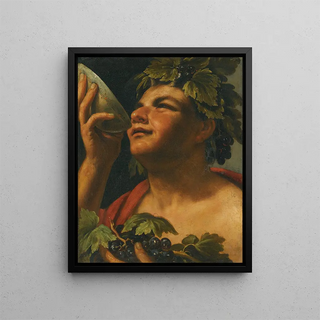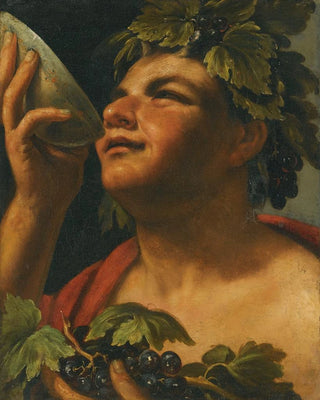Art print | Bacchus - Caravaggio School


View from behind

Frame (optional)
Bacchus Art print - School of Caravaggio – Captivating Introduction
The depiction of the Roman god Bacchus, symbol of the vine and intoxication, has always fascinated artists through the ages. In the Bacchus art print - School of Caravaggio, this mythological figure comes to life in an atmosphere that is both sensual and dramatic, typical of the baroque style. The light, omnipresent, illuminates Bacchus's features, accentuating his expressions and revealing a psychological depth that invites contemplation. This work, far from being a simple illustration of mythology, becomes a true mirror of human passions, a reflection of ecstasy and debauchery. Immersed in this composition, the viewer is transported to a time when art and life intertwined in an intoxicating dance.
Style and uniqueness of the work
The style of the School of Caravaggio is characterized by a striking chiaroscuro, where light and shadow engage in a visual battle. This technique, executed brilliantly in the depiction of Bacchus, creates a powerful contrast that draws the eye and guides the gaze across the canvas. Rich and deep colors, combined with meticulous details, give the work an almost tangible texture. Bacchus, surrounded by fruits and wine, embodies abundance and sensuality, while his gaze, both seductive and mysterious, seems to invite the viewer to share a moment of intimacy with the divine. The dynamic composition, with flowing lines and expressive poses, demonstrates the artist's technical mastery, capturing the very essence of celebration and festivity.
The artist and his influence
The School of Caravaggio, although often associated with a single man, consists of numerous artists influenced by master Caravaggio himself. The latter, with his innovative approach to light and realism, paved the way for a new artistic era. His disciples, some of whom contributed to the creation of the Bacchus art print - School of Caravaggio, mastered these techniques while adding their own sensitivity. The legacy of Caravaggio is reflected in

Matte finish

View from behind

Frame (optional)
Bacchus Art print - School of Caravaggio – Captivating Introduction
The depiction of the Roman god Bacchus, symbol of the vine and intoxication, has always fascinated artists through the ages. In the Bacchus art print - School of Caravaggio, this mythological figure comes to life in an atmosphere that is both sensual and dramatic, typical of the baroque style. The light, omnipresent, illuminates Bacchus's features, accentuating his expressions and revealing a psychological depth that invites contemplation. This work, far from being a simple illustration of mythology, becomes a true mirror of human passions, a reflection of ecstasy and debauchery. Immersed in this composition, the viewer is transported to a time when art and life intertwined in an intoxicating dance.
Style and uniqueness of the work
The style of the School of Caravaggio is characterized by a striking chiaroscuro, where light and shadow engage in a visual battle. This technique, executed brilliantly in the depiction of Bacchus, creates a powerful contrast that draws the eye and guides the gaze across the canvas. Rich and deep colors, combined with meticulous details, give the work an almost tangible texture. Bacchus, surrounded by fruits and wine, embodies abundance and sensuality, while his gaze, both seductive and mysterious, seems to invite the viewer to share a moment of intimacy with the divine. The dynamic composition, with flowing lines and expressive poses, demonstrates the artist's technical mastery, capturing the very essence of celebration and festivity.
The artist and his influence
The School of Caravaggio, although often associated with a single man, consists of numerous artists influenced by master Caravaggio himself. The latter, with his innovative approach to light and realism, paved the way for a new artistic era. His disciples, some of whom contributed to the creation of the Bacchus art print - School of Caravaggio, mastered these techniques while adding their own sensitivity. The legacy of Caravaggio is reflected in






